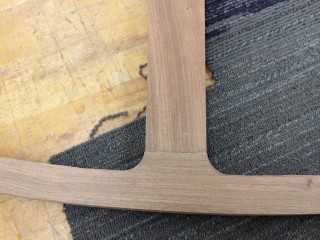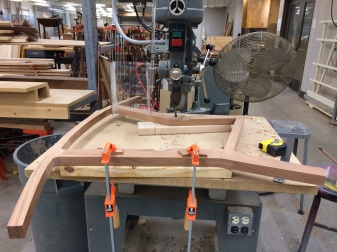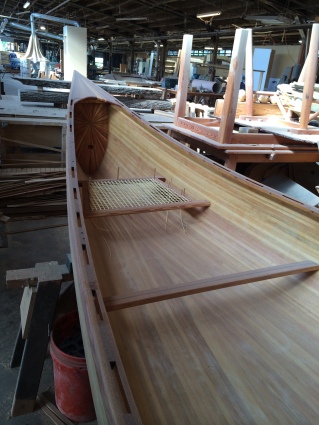 I sit in on a class called “Timber Technologies” and this week we went to Delta Millworks here in Austin to learn about Shuo Sugi Ban, a Japanese method of burning wood to make it more resistant to rot and insects. Oh, and they just so happen to have a tenant in their space named Aldo Bohm who built this amazing canoe. It’s made entirely of scrap material (mostly longleaf pine, and some mesquite) and the strips are only a quarter inch thick. I would have taken a photo of the whole thing except that it was surrounded by architecture students (not that they’re not attractive enough, but it takes away from the majesty of the piece itself).
I sit in on a class called “Timber Technologies” and this week we went to Delta Millworks here in Austin to learn about Shuo Sugi Ban, a Japanese method of burning wood to make it more resistant to rot and insects. Oh, and they just so happen to have a tenant in their space named Aldo Bohm who built this amazing canoe. It’s made entirely of scrap material (mostly longleaf pine, and some mesquite) and the strips are only a quarter inch thick. I would have taken a photo of the whole thing except that it was surrounded by architecture students (not that they’re not attractive enough, but it takes away from the majesty of the piece itself).
Anyway, Delta specializes in reclaimed lumber and Shuo Sugi Ban. They gave us a little demo of how they char the wood on the outside and then seal it. 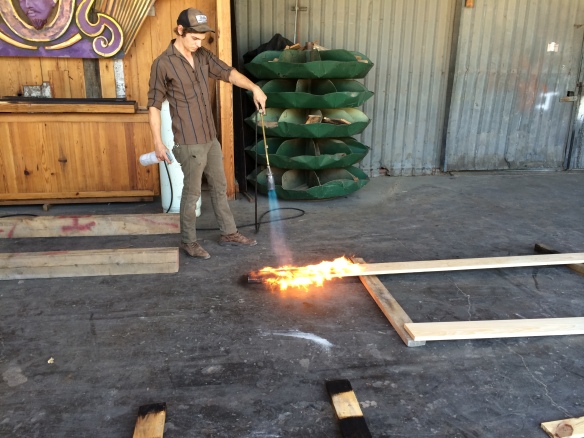 This job seems like every little boy’s dream–burning stuff. None of the burnt wood is structural. It’s primarily used as siding and flooring and it looks really cool.
This job seems like every little boy’s dream–burning stuff. None of the burnt wood is structural. It’s primarily used as siding and flooring and it looks really cool. 
I also had to get some of my own work done this week. I trimmed off the excess lamination material on the rockers. It seemed simple enough to just run it through the band saw and then sand it down, but it didn’t occur to me that I wouldn’t be able to get the band saw into the inside of the frame (duh), so I had to cut those ends by hand with the Japanese saw. Lots of Japanese methods happening this week apparently. After they were cut down close to size, I used the spindle sander to get the curves smoothed out and the transition from leg to rocker flush. I’m generally pretty happy with how they turned out, except I cut into one of them a little too deep and now I have to fill it (I made the mistake by hand, not with a machine. Remember David Pye’s idea of the workmanship of risk? Yep).
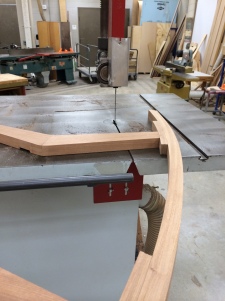
Next up was fixing the joint that opened by running dowels through the tenon. I bought a half-inch, mahogany dowel from Woodcraft and used the drill press with a half-inch forstner bit. The drill press makes sure the bit goes in straight, and also allows you to control the depth of the cut. The nice thing about using two things that you know are a half inch in diameter from the beginning is that you know they will fit together well. I put glue in the holes as well as on the dowel, banged them in with a mallet, and left them to dry.
Since the next order of business is re-cutting the joints on the seat so that they properly grab on to the joints on the leg frames, I sharpened my chisel.
This is done by touching it to the grinding wheel. Sparks fly when you do this, which makes it seem like you’re doing something really hardcore. After the wheel you rub it on the whetstones, like when sharpening a scraper. You go from coarse to fine. A sharp chisel will shave off your arm hair. That’s how I determine it’s ready to use–a quick arm shaving.




